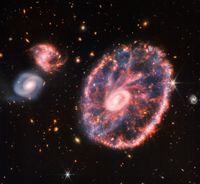
Photo from wikipedia
We investigate the stability of nearby disc galaxies and galaxies at redshift (z) equal to 4.5. We explore the connection between the stability parameter (QRW), star formation rate (SFR), gas… Click to show full abstract
We investigate the stability of nearby disc galaxies and galaxies at redshift (z) equal to 4.5. We explore the connection between the stability parameter (QRW), star formation rate (SFR), gas fraction (fGas), and the time scale for growth of gravitational instabilities (τ). We find that, despite differences in morphology 91 % of the nearby galaxies have a minimum value of stability parameter ($Q^{Min}_{RW}$) greater than 1 indicating stability against the growth of axisymmetric instabilities. The spirals in our sample have higher median star formation rate, lower median QRW, a lower fGas and small time scale for growth of gravitational instabilities than irregular galaxies. We find that the gravitational instabilities in spirals convert a large fraction of gas into stars quickly, depleting the gas reservoirs. On the other hand, star formation occurs more gradually over longer timescales in irregulars with a higher gas fraction. We then compare the stability of the nearby galaxies with galaxies at z = 4.5. We find that net stability levels in the nearby galaxies and the galaxies at z = 4.5 are primarily driven by the stellar disc suggesting the presence of an inherent mechanism that self-regulates the stability. Finally, upon removing the contribution of the dark matter to the total potential, the median QRW for the nearby galaxies and galaxies at z = 4.5 remains unchanged indicating that the baryons can self-regulate the stability levels, at least in a statistical sense.
Journal Title: Monthly Notices of the Royal Astronomical Society
Year Published: 2023
Link to full text (if available)
Share on Social Media: Sign Up to like & get
recommendations!